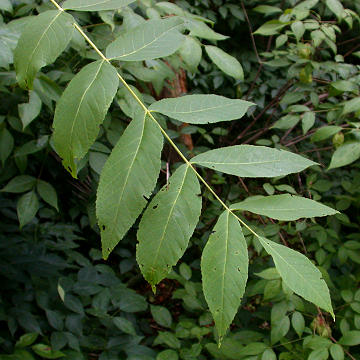

Juglans cinerea - (image 1 of 6)
Taxonomy
Family: Juglandaceae
Habitat
Rich, moist soil. Mesic woods, floodplains. Springy, wooded calcareous slopes.
Associates
Distribution
New Brunswick to MN, south to SC, GA, and AR.
Morphology
Large tree, to 30 m high. Leaves alternate, pinnate compound with 11-17 leaflets, the terminal leaflets usually well-developed; leaflets oblong-lanceolate, acuminate, appressed-serrate, pubescent and glandular beneath. Stems stout, pubescent to smooth and reddish buff to greenish gray; twigs with dark brown, chambered pith; bark smooth or lightly furrowed; ridges whitish, furrows dark-gray; inner bark turning yellow on exposure to air. Flowers monoecious, green to brown. Fruit a fleshy drupe, broadly ellipsoid, with a hard, stony endocarp, lrough, with 2 or 4 obscure longitudinal ridges; kernel, sweet, oily.
Notes
Flowers late April to early June
Wetland indicator: Facultative Upland
Most easily separated from J. nigra by the stems, which have dark brown pith (pale in J. nigra), downy reddish hairs above the leaf scar (notched in J. nigra with no hairs). In addition, the terminal leaflet in J. cinerea is usually well-developed and either poorly developed or absent in J. nigra.
The bark was once used as an orange or yellow dye. An introduced fungus called butternut canker (Sirococcus clavigignenti-juglandacearum) has decimated many wild populations of Butternut and has made this species rather rare in many areas.
References
Dirr, Michael A. 1998. Manual of Woody Landscape Plants:
Their Identification, Ornamental Characteristics, Culture, Propagation and Uses.
5th ed. Champaign, Illinois: Stipes Publishing L.L.C.
Gleason, Henry A.
and A. Cronquist. 1991. Manual of Vascular Plants of Northeastern United States
and Adjacent Canada. Second Ed.
The New York Botanical Garden. Bronx, NY
Swink, F. and G.
Wilhelm. 1994. Plants of the Chicago Region.
Indiana Academy of Science. The Morton Arboretum. Lisle, Illinois.
|
Michael Hough © 2009 |